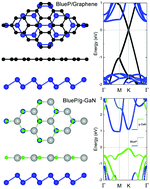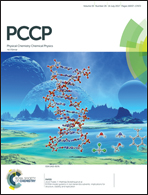Electronic properties of blue phosphorene/graphene and blue phosphorene/graphene-like gallium nitride heterostructures†
Abstract
Blue phosphorene (BlueP) is a graphene-like phosphorus nanosheet which was synthesized very recently for the first time [Nano Lett., 2016, 16, 4903–4908]. The combination of electronic properties of two different two-dimensional materials in an ultrathin van der Waals (vdW) vertical heterostructure has been proved to be an effective approach to the design of novel electronic and optoelectronic devices. Therefore, we used density functional theory to investigate the structural and electronic properties of two BlueP-based heterostructures – BlueP/graphene (BlueP/G) and BlueP/graphene-like gallium nitride (BlueP/g-GaN). Our results showed that the semiconducting nature of BlueP and the Dirac cone of G are well preserved in the BlueP/G vdW heterostructure. Moreover, by applying a perpendicular electric field, it is possible to tune the position of the Dirac cone of G with respect to the band edge of BlueP, resulting in the ability to control the Schottky barrier height. For the BlueP/g-GaN vdW heterostructure, BlueP forms an interface with g-GaN with a type-II band alignment, which is a promising feature for unipolar electronic device applications. Furthermore, we discovered that both G and g-GaN can be used as an active layer for BlueP to facilitate charge injection and enhance the device performance.



 Please wait while we load your content...
Please wait while we load your content...